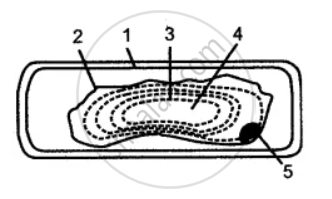Advertisements
Advertisements
प्रश्न
Differentiate between the following:
Turgidity and Flaccidity
उत्तर
| Turgidity | Flaccidity | ||
| 1. | It is the state of a cell in which the cell cannot accommodate any more water and is fully distended. | 1. | It is the condition in which the cell content is shrunken and the cell is not tight. |
| 2. | The availability of sufficient water causing the cells to become charged with water with its walls in a state of tension making the cells rigid and stretched. | 2. | The unavailability of sufficient water causes the cells to become weak and soft due to decreased turgor pressure. |
| 3. | This condition causes wilting in plants. | 3. | This condition makes plants stiff and erect. |
APPEARS IN
संबंधित प्रश्न
Give scientific reasons : Balsam plants wilt during mid-day even if the soil is well watered.
Give the equivalent term for the following:
The condition in which the cell contents are shrunken.
What is the difference between ‘flaccid’ and ‘turgid’? Give one example of flaccid condition in plants.
Give suitable biological reasons for the following statement:
Root hairs become flaccid and droop when excess fertilizers are added to the moist soil around them.
Differentiate between:
Turgid and Flaccid.
Differentiate between the following
Turgor pressure and Root pressure
Differentiate between the following:
Plasmolysis and Deplasmolysis.
The below diagram represents a plant cell after being placed in a strong sugar solution. Guidelines 1 to 5 indicate the following:
1. Cell wall
2. Plasma membrane.
3. Protoplasm
4. Large vacuole
5. Nucleus
Study the diagram and answer the questions that follow :
(i) What is the state of the cell shown in the diagram?
(ii) Name the structure which acts as a selectively permeable membrane.
(iii) If the cell had been placed in distilled water instead of a strong sugar solution which features: would not have been present?
(iv) If the cell in the diagram possessed chloroplasts where would these be present?
(v) Name any one feature of this plant cell which is not present in animal cells.
Name the following:
The process by which wilting or drooping of leaves occurs.
Fill in the Blank
Wilting and drooping of leaves is due to loss of ________.
